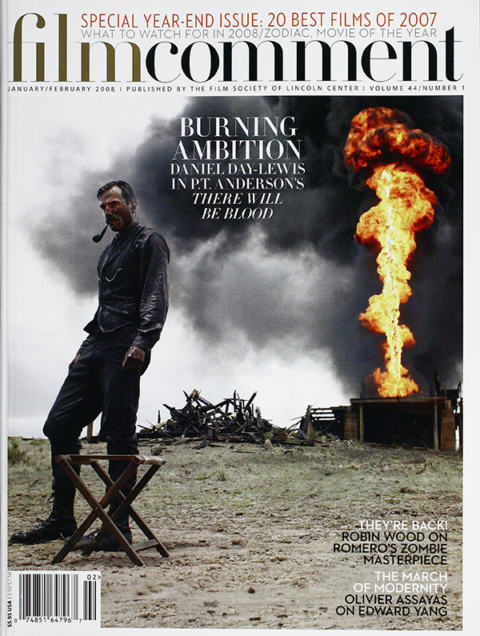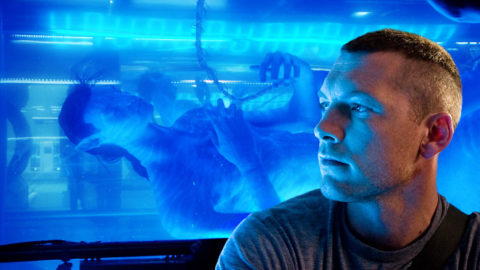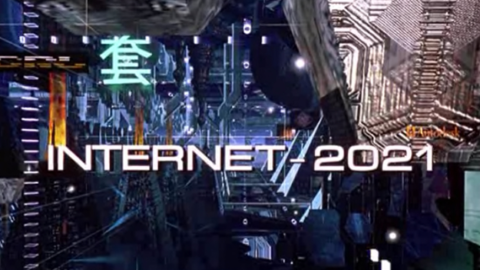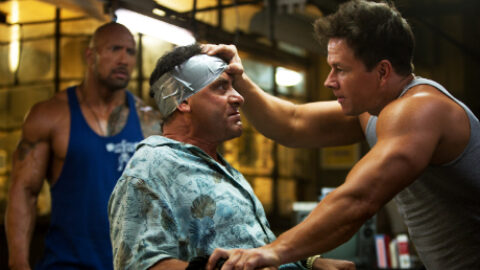
Rarely has a filmmaker inherited a premise more suited for a digital-effects makeover than the Transformers animated TV show, which ran from 1984 to 1987. It was, after all, a series whose narrative component was reverse-engineered from the mechanical possibilities of a shape-shifting toy. But this seems to have been a mixed blessing for Michael Bay, a director known for “high-octane” films like The Rock, Armageddon, and Bad Boys that tend to put quippy dialogue in the driver’s seat. In Bay’s Transformers, the irreverent jokes and supposedly self-conscious deprecation are, at the very least, riding shotgun. But the film’s real transgression lies less in its trivially developed character relations than in its fundamental inability to utilize or perhaps even see the merit of embracing the austerely mechanical pleasure around which its progenitor—a children’s toy line—had centered itself. Transformers treats the interstellar robots’ metamorphoses as the basis for a spectacle that amounts to little more than a kind of protracted car chase, its moves inappropriately borrowed from the vernacular of The Fast and the Furious et al. As such, its devotion to perfunctory Nitrous boosts and explosions unhinge the potential for the careful unfurling of intricately related, almost delicately beautiful forms as would have been a more appropriate translation of the toys, which often required fine motor skills and Rubik-like planning from their users. So, while Transformers was one of the better action films this summer, it missed its chance to become a landmark in digital effects filmmaking by playing safe.
Bay and Industrial Light & Magic’s spectacularly choreographed sequences seem to have been drawn straight from the imaginations of children whose physical actualizations of their playtime musings with Transformer toys could never rival the kinematic glories rendered in the film. Considering the fact that an original Optimus Prime Transformer toy had approximately 50 parts while the film’s computer-generated model of the same character was comprised of 10,000 pieces and its movement was not bound to the limits of manual dexterity, it’s no wonder that the film was able to create a mechanical precession of which toy enthusiasts could only dream.
In one scene from the film, an F-16 jet flies just above water level toward the Hoover Dam, then quickly transforms into a humanoid robot that grabs onto a bridge, lifts itself up, and flexes its mechanical muscles with caricatured masculinity. Whether through a child’s play or digital animation, such a performance can only be achieved by a labored and fragmented process. For the CG model, an animator shapes the transformative gesture from the ground up, blocking out the principal elements of the motion in rough keyframes and then improving upon each until the entire enactment is natural looking. Similarly, a child must form the transformation piece by piece—moving one arm, then the other, and so forth. The difference, of course, is that once the gesture has been mapped out in its constituent parts, the labor of the CG animation process is temporally flattened so that in playback, the transformation is presented as a single, smooth gesture. The CG artist has the additional advantage of being able to dynamically link a gesture’s elements so that, for instance, the next time he wishes to move the hand, the rest of the arm will follow in a realistic manner. The manual animation of the toy, on the other hand, is never in “real time.”

3-D modeling and animation seem to be perfect extensions of the type of reconfigurative thinking fostered in childhood play by toys like Transformers, Lego, and building blocks. Presumably, part of Bay’s vision for Transformers was to employ digital technology to fulfill the unrealized potential of our imaginative (though technically lacking) play. The film presents its CG characters as thrilling new gadgets that slide and twist in every way imaginable to reveal every bell, whistle, and hubcap. At its most exciting, Transformers provides the pure pleasure of reconfiguration through its fanciful presentation of moving parts. This excitement is tempered, though, by the feeling that you are watching over someone’s shoulder as they play with a new toy.
The transformations from helicopter, fighter jet, and General Motors vehicles into their humanoid robotic counterparts take place quickly and though many occur right before our eyes, it’s often difficult to make out exactly what is happening. The masking of CG characters with rapid edits and shaky cameras has been a trademark of digital depiction. This “MTV style” preserved the illusion of realism in films in which digital effects could not meet the challenge of close scrutiny. But the digital figures in Transformers look great and so the rapid-cut style is superfluous—the thoughtless perpetuation of an obsolete constraint by a filmmaker who doesn’t quite grasp the merits of the technical power to which he and few others have access. The film’s Transformers are awesome and you want only to get your hands on them and reconfigure them for yourself. Instead, you receive a rushed tutorial in the shiny gadget’s many cool functions and then watch with disappointment as Industrial Light & Magic puts the toy back in its pocket. “Sorry, my mom said I shouldn’t lend it to anyone.”
The director of a digital-effects film is endowed with the privilege of translating the contents of his imagination into a moving image. Yet every child has access to something much greater, something from which directors like Michael Bay could learn a great deal. It is precisely the technical limitations of a toy that afford a child’s imagination an opportunity to produce its own transcendent reality. The child must learn to think around the problem of objective limitations, and in consciously performing the negation of a constraint such as gravity or the temporal fragmentation necessary in forming a toy’s gesture, doubt is cast upon all those things for which rules seemingly apply. It is here—in the contradiction of “law” and against the adversity of never being able to see one’s vision fully realized—that the truly inventive narrative takes form.

The digital artist faces no physical adversity—no laws need to be subverted. On the contrary, in a 3-D modeling environment, if gravity or even the causal relations of one object striking another are necessary to a scene, they must be programmed into it. Only the laws of perspectival optics are predetermined in 3-D modeling software (and even these are not absolute). As a result, in the infancy of digital-effects filmmaking, directors have lost sight of a certain realization, which greatly informed the cinema of the latter half of the 20th Century—film theorist André Bazin’s statement that, “The screen reflects the ebb and flow of our imagination which feeds on a reality for which it plans to substitute. That is to say, the tale is born of an experience that the imagination transcends.”
The tenet that cinema projects an objective reality under which a deeper meaning is brought to life by the codifying and decoding processes of the filmmaker and viewer respectively seems to be outmoded in digital Hollywood. Perhaps this is because the digital cinema, unlike its predecessor, requires the artist to simultaneously produce the “objective reality” while also codifying its ambiguity for the viewer to interpret. This fundamental shift in the way films are conceived—the fact that the computer-generated environment begins as a blank slate upon which significance must be layered—requires something new of filmmakers, but also affords the opportunity for the emergence of an entirely novel visual language, one whose advent we continue to await.
Everything comes easily in the virtual world and this means that directors must find ways of suppressing the urge to pack a film with every possible delight they can imagine, of allowing the viewer to find “more than meets the eye.” Perhaps to some extent we can fault toys like the Transformers for the imaginative shortcomings of today’s filmmaking environment. By the Eighties, Lego and the improvised, makeshift employment of, say, toilet-paper tubes and aluminum foil as playthings were giving way to single-function toys that allowed a child to don a Ghostbusters Proton Pack, press a button to hear an action figure recite lines of dialogue from a movie, or witness a doll actually wetting her pants—but invited no further involvement.

Admittedly, the Transformers were far less stifling to the imagination than such toys. Rather than offering a single ready-made path of interactivity, they afforded a framework that to some extent could be expanded upon, subverted, and recontextualized. Yet in these toys—as opposed to open-ended materials—it is easy to fall back on the toy’s preset function or narrative. Similarly, digital filmmakers will only be able to make use of the limitless potential of their computer-generated environments if they learn to take stock of the specific advantages that these ultimate in open-ended materials offer. For Bay, the safety net of a predetermined structure was, to some extent, inevitable. In producing an adaptation or remake, a filmmaker is responsible for upholding the legacy upon which the brand was built. However, the narrative in which Bay chooses to embed the Transformers—the “Shia-LaBeouf-buys-a-car-and-finds-out-it’s-an-alien-robot” story—doesn’t hail from anywhere in the Transformer mythology. Nor does the now-you-see-it, now-you-don’t sleight of hand depiction of the transformation process do justice to the franchise’s original concept.
Steven Spielberg, the executive producer of Transformers, has said that what made Jaws so frightening was the result of a technical limitation in trying to produce a realistic-looking shark. In the absence of a convincing model, Spielberg was forced to limit the shark’s screentime. As a result, the antagonist’s presence in the film is delightfully ominous—a dark figure lurking just below the surface. Without their consent, viewers were drawn into the action—their imaginations conjured a creature more terrifying than any special-effects creation.
Bay doesn’t achieve this level of viewer engagement precisely because he tries to do all the work for you. It’s not that his vision for the robot-battle choreography is unimaginative. Rather, he lacks imagination to provide viewers with a way of putting all the pieces together for themselves. The Ideal form—be it divine or grotesque—can only fully exist in the mind. Yet, the CG modeling environment provides a point of access to the Ideal—a space in which objects are not constrained by the dictates of the physical laws to which they are ordinarily bound and related. So why not let viewers revel in that freedom? Why not make computer graphics a better gateway to the Ideal we imagine? In the end, a computer is really just an imperfect model of the human mind, a model whose grounding in the pure mathematics of our reality allows us to access the true freedom that our worldly confinement seems to deny.








